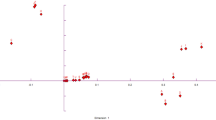Abstract
The allele frequencies and forensically relevant parameters for the 22 autosomal short tandem repeats (STRs) present in PowerPlex® Fusion (Promega, Madison, WI) were determined for 357 unrelated individuals from 11 states across India. The combined power of discrimination and probability of exclusion were 0.99999999999999999999999999875 and 0.999999997200846, respectively. The panel was found to be informative for Indian populations and generated a total of 275 alleles. Further, analyses with these loci did not show any noticeable clustering among the Indian populations.
Similar content being viewed by others
References
Hares DR (2015) Selection and implementation of expanded CODIS core loci in the United States. Forensic Sci Int: Genet 17:33–34. doi:10.1016/j.fsigen.2015.03.006
Turrina S, Ferrian M, Caratti S, De Leo D (2014) Evaluation of genetic parameters of 22 autosomal STR loci (PowerPlex®Fusion System) in a population sample from Northern Italy. Int J Legal Med 128:281–283. doi:10.1007/s00414-013-0934-4
Miller SA, Dykes DD, Polesky HF (1988) A simple salting out procedure for extracting DNA from human nucleated cells. Nucleic Acids Res 16:1215
Tereba A (1999) Tools for analysis of population statistics. Profiles in DNA 2:14–16. Promega Corporation. http://www.promega.com/geneticidtools/powerstats. Accessed 9 June 2006
Peakall ROD, Smouse PE (2006) GenAlEx 6: genetic analysis in Excel. Population genetic software for teaching and research. Mol Ecol Notes 6:288–295. doi:10.1111/j.1471-8286.2005.01155.x
Peakall R, Smouse PE (2012) GenAlEx 6.5: genetic analysis in Excel. Population genetic software for teaching and research—an update. Bioinformatics 28:2537–2539. doi:10.1093/bioinformatics/bts460
Yeh FC, Boyle TJB (1997) Population genetic analysis of co-dominant and dominant markers and quantitative traits. Belgian J of Bot 129:1
Excoffier L, Lischer HE (2010) Arlequin suite ver 3.5: a new series of programs to perform population genetics analyses under Linux and Windows. Mol Ecol Resour 10:564–567. doi:10.1111/j.1755-0998.2010.02847.x
Pritchard JK, Stephens M, Donnelly P (2000) Inference of population structure using multilocus genotype data. Genetics 155:945–959
Earl DA, von Holdt BM (2012) STRUCTURE HARVESTER: a website and program for visualizing STRUCTURE output and implementing the Evanno method. Conserv Genet Resour 4:359–361. doi:10.1007/s12686-011-9548-7
Rosenberg NA (2004) distruct: a program for the graphical display of population structure. Mol Ecol Notes 4:137–138. doi:10.1046/j.1471-8286.2003.00566.x
Rosenberg NA, Mahajan S, Gonzalez-Quevedo C et al (2006) Low levels of genetic divergence across geographically and linguistically diverse populations from India. PLoS Genet 2:e215. doi:10.1371/journal.pgen.0020215
Poetsch M, Bajanowski T, Pfeiffer H (2012) The publication of population genetics data in the International Journal of Legal Medicine: guidelines. Int J Legal Med 126:489–490
Acknowledgements
We thank Promega Corporation for providing PowerPlex® Fusion reagents (Promega, Madison, WI, USA), Devinder Kumar for the sample collection, and Anujit Sarkar for the useful discussions. We are also grateful to all the volunteers for their participation in this study. This research was funded by core grants of Centre for DNA Fingerprinting and Diagnostics, India. M.S. was the recipient of Junior and Senior Research Fellowships of the Council of Scientific and Industrial Research (CSIR), India, towards the pursuit of a Ph.D. degree at the Manipal University, India.
Author information
Authors and Affiliations
Corresponding author
Ethics declarations
Conflict of interest
None
Electronic supplementary material
ESM 1
(PDF 472 kb)
Rights and permissions
About this article
Cite this article
Singh, M., Nandineni, M.R. Population genetic analyses and evaluation of 22 autosomal STRs in Indian populations. Int J Legal Med 131, 971–973 (2017). https://doi.org/10.1007/s00414-016-1525-y
Received:
Accepted:
Published:
Issue Date:
DOI: https://doi.org/10.1007/s00414-016-1525-y



